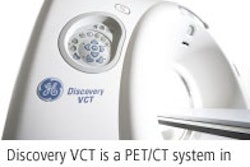Mild cognitive impairment (MCI) is a clinical diagnosis used to describe patients with a decline in cognitive performance that is more pronounced than expected age-related changes but not yet sufficient for a diagnosis of dementia. Although patients with MCI are able to function in everyday activities, such as managing their personal finances and making purchases without assistance, they represent a risk population for progressing to dementia of the Alzheimer type (DAT).
"However, in patients selected by clinical criteria alone, the clinical syndrome of MCI may be caused by many other underlying conditions, such as cerebrovascular disease or depression, so that the prognosis of individual MCI patients is highly variable," wrote a multinational team of researchers from Germany, Australia, and the U.S.
The group recently published the results of a longitudinal, prospective study that examined the value of F-18 FDG-PET imaging of cerebral glucose metabolism and genetic susceptibility, as defined by an apolipoprotein E (APOE)-e4-positive genotype, with regard to the early diagnosis of DAT in patients with MCI (Journal of Nuclear Medicine (October 2005, Vol. 46:10, pp. 1625-1632).
PET imaging of glucose metabolism in the brain can accurately predict which patients with mild cognitive impairment will progress to full-blown Alzheimer's dementia, according to the researchers.
The study included 30 patients with the diagnosis of MCI (16 females and 14 males with an average age of 70 years) who underwent a baseline exam and a follow-up exam 16 months later. The mean age at the onset of memory problems for the patient group was 68 years.
"The baseline diagnostic work-up included an interview with the patient and informant; medical, psychiatric, and neurologic examinations (performed by an experienced psychiatrist); routine blood screening; and APOE genotyping," the researchers wrote.
The group also conducted cranial MRI scans (1.5-tesla Magnetom Symphony, Siemens Medical Solutions, Malvern, PA) to assess structural brain abnormalities and cranial FDG PET (951 R/31 PET scanner, Siemens) to determine cerebral metabolism. The PET data were screened for findings suggestive of Alzheimer's disease, with the help of an automated computer program (NeuroStat, University of Michigan, Ann Arbor). The brain activity of each patient was then compared with a reference normal database consisting of 22 age-matched healthy control subjects.
PET scans suggested a likelihood of Alzheimer's dementia in 13 (43%) patients, and 17 (57%) of the patients did not show Alzheimer's-suggestive abnormalities, according to the researchers. They reported that 11 of the 13 PET-positive patients proceeded to manifest DAT in the 16-month study period, and that 16 of the 17 PET-negative patients remained clinically stable.
The PET scans demonstrated a sensitivity of 92%, a specificity of 89%, a positive predictive value of 85%, and an accuracy of 90%.
The APOE tests suggested susceptibility of Alzheimer's dementia in 17 patients, and nine people in this group proceeded to manifest DAT. Three of the 13 patients who did not show a genetic susceptibility for Alzheimer's progressed to dementia over the 16-month study duration.
"However, it cannot be excluded that some of these patients will progress to DAT later on and longer observation periods are required to clarify this point," the authors noted.
Genetic testing demonstrated a sensitivity of 75%, a specificity of 56%, a positive predictive value of 53%, and accuracy of 63%.
The researchers also examined the data in regard to a combination of both PET and APOE gene typing for predicting Alzheimer's disease. Of the original study cohort, eight patients had both suggestive PET scans and genetic susceptibility, and all manifested DAT. Eight patients who had negative PET scans and negative APOE gene typing remained clinically stable. Four of the remaining 14 patients who had a positive PET scan or demonstrated genetic susceptibility for Alzheimer's progressed to DAT.
Combining PET and APOE gene typing had a sensitivity of 67%, a specificity of 100%, a positive predictive value of 100%, and a test accuracy of 87%.
"In the current study, more than one-third of the MCI patients had proceeded to manifest DAT at the date of follow-up examination, and more than half did not show progression to dementia," the authors wrote. "These results confirm that MCI patients, even when selected carefully after clear inclusion criteria, represent a very heterogeneous group with regard to prognosis."
The researchers believe that the results of the study, although plausible and promising, suggest the need for further studies with longer follow-up periods and larger patient samples. As such, they cautioned that their statistical values must be regarded as preliminary and cannot be uncritically transferred to the MCI population in general.
By Jonathan S. Batchelor
AuntMinnie.com staff writer
November 10, 2005
Related Reading
Daydreaming activity linked to Alzheimer's, August 25, 2005
Studies show ways to predict, prevent Alzheimer's, June 20, 2005
Complexities of normal pressure hydrocephalus bedevil neurological experts, March 24, 2005
PET scan predicts risk of Alzheimer's disease, December 17, 2004
New study looks into brains of Alzheimer's patients, October 14, 2004
Copyright © 2005 AuntMinnie.com




















